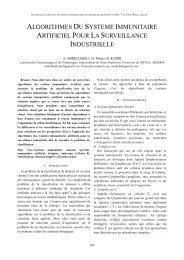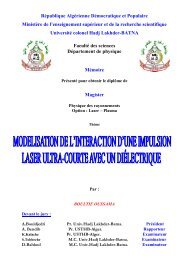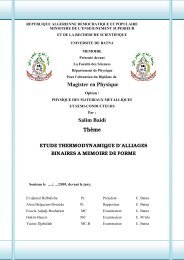Europe's Quest for the Universe - Laboratoires de Recherche
Europe's Quest for the Universe - Laboratoires de Recherche
Europe's Quest for the Universe - Laboratoires de Recherche
You also want an ePaper? Increase the reach of your titles
YUMPU automatically turns print PDFs into web optimized ePapers that Google loves.
46 Europe’s quest <strong>for</strong> <strong>the</strong> <strong>Universe</strong><br />
neglected <strong>the</strong> problems associated with <strong>the</strong> combination of <strong>the</strong> light from <strong>the</strong><br />
telescopes and <strong>the</strong> cost of <strong>the</strong> instrumentation. But it showed that it was not<br />
an excessively ambitious aim to build a 16-m equivalent telescope. I ma<strong>de</strong><br />
<strong>the</strong> first proposal to do so at <strong>the</strong> ESO conference “Optical Telescopes of <strong>the</strong><br />
Future” held in Geneva, December 1977 5) . At this conference many interesting<br />
i<strong>de</strong>as were presented which also helped to fur<strong>the</strong>r crystallize our own. Of<br />
course, <strong>the</strong> mo<strong>de</strong>l of twenty 3.6-m telescopes was not a particularly attractive<br />
option, but it could easily be costed. A more ambitious project with larger<br />
unit telescopes was called <strong>for</strong>, but nee<strong>de</strong>d more analysis.<br />
At <strong>the</strong> time I listed just five illustrative examples of what such a<br />
telescope would do. They were <strong>the</strong> following:<br />
1. Abundances of elements in globular cluster stars. Composition variations<br />
were believed to be due to differences in <strong>the</strong> elemental abundances of <strong>the</strong><br />
gaseous medium from which such stars <strong>for</strong>med, but since only evolved stars<br />
could be observed effects of stellar evolution could also play a role. But<br />
a<strong>de</strong>quate analysis of unevolved stars was hardly possible because <strong>the</strong>y<br />
were too faint <strong>for</strong> 4-m class telescopes. Actually <strong>the</strong> VLT has been used<br />
extensively to study <strong>the</strong> abundances of cluster and halo stars.<br />
2. The motion of globular clusters in o<strong>the</strong>r galaxies in<strong>for</strong>ms us about <strong>the</strong>ir<br />
masses and about <strong>the</strong>ir “dark matter” content.<br />
3. Cosmological studies involving faint galaxies and quasars would be of<br />
much importance. While <strong>the</strong> faintest objects might best be <strong>de</strong>tected with<br />
<strong>the</strong> Hubble Space Telescope, more <strong>de</strong>tailed spectroscopy of somewhat<br />
brighter objects would be <strong>the</strong> domain of <strong>the</strong> 16-m telescope. This complementarity<br />
has been very much in evi<strong>de</strong>nce with <strong>the</strong> VLT.<br />
4. Correlative optical studies of radio and X-ray sources. In fact, extremely<br />
faint counterparts to X-ray sources have been found at <strong>the</strong> limit of what<br />
<strong>the</strong> VLT can observe.<br />
5. High time resolution photometry of X-ray sources. Today one would have<br />
replaced this by observations of remote supernovae to <strong>de</strong>termine <strong>the</strong><br />
structure of <strong>the</strong> <strong>Universe</strong>.<br />
Of course, many o<strong>the</strong>r topics could have been listed, in particular also<br />
in <strong>the</strong> infrared.<br />
To me it seemed highly premature to go in one step to a 16-m telescope.<br />
ESO had constructed a mo<strong>de</strong>rately satisfactory 3.6-m. The USSR 6-m<br />
telescope was <strong>the</strong> largest in <strong>the</strong> world. It was a heavy monster. Just scaling<br />
up <strong>the</strong>se telescopes to 16-m was not going to work. The step to 16 m was too<br />
large. If something would go wrong, <strong>the</strong> loss would be total. On <strong>the</strong> o<strong>the</strong>r<br />
hand, <strong>the</strong> optical combination of a large number of small telescopes would<br />
lead to important light losses, which could <strong>de</strong>feat <strong>the</strong> aim of efficient photon<br />
collection. And if all of <strong>the</strong>se would be individually instrumented, <strong>the</strong> cost<br />
of <strong>the</strong> instruments might become a large part of <strong>the</strong> total. While such an array<br />
might yield high angular resolution on bright objects when used in an interferometric<br />
mo<strong>de</strong>, <strong>for</strong> <strong>the</strong> imaging of very faint objects it would be far from






